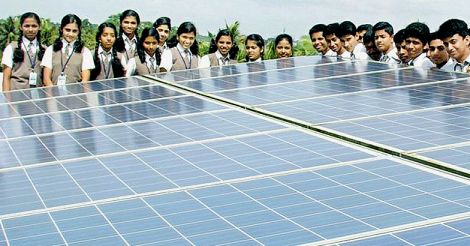Call it adaptability or the propensity to make use of adversity, but Keralites- who once used to boast about the water resources of the state- are now tapping the power of the sun even as rivers and streams are fast drying up in the state. Even as another major hydro-power project would be too costly for the state in terms of money and ecology, the sun offers solace for the Keralite whose power consumption is set to only increase in the coming years.
A solar power-generating system that was installed at the Nedumbassery Airport has caught national attention and is now serving as a model for others to follow, within and outside the state.
There are two kinds of solar power managing systems that are operational in Kerala now: the off-grid system and the grid-connected solar system. In the off-grid system, power is typically produced and used, or stored, where it is produced- such as homes and offices. In the grid-connected system, power produced is distributed to a grid from where it is tapped only when needed. This would mean that power produced is distributed to those points where it is immediately needed. The main difference between the two is cost, with the grid-connected system cutting installation costs by about half because costly batteries for storing power are not needed. A 1 kW off-grid system would cost about Rs 1.5 lakhs while the grid-connected system would cost about Rs 85,000 to set up.
An astute, cost-conscious consumer may be prompted to opt against solar systems because of initial costs and recurring maintenance charges. However, those who are installing these systems now are doing it to become part of a movement that aims for self-sufficiency in power in the next 10 to 30 years. As traditional hydro power systems have become unsustainable and as power consumption is set to increase, there is no other go than tapping the sun for power and that is exactly what agencies such as ANERT are trying to encourage.
The solar system at the Nedumbassery airport produces about 13.1 MW of power and this is set to double when a new terminal is readied at the airport. Perhaps encouraged by the system, Vishwajyothi Public School in Angamali has commissioned a solar-power system that produces 100 kW of solar power that is connected to the grid. The system was setup at a cost of about Rs 45 lakhs. The system has been running for three months now and the school which used to spend about Rs 80,000 a month for its power needs is now generating free electricity. The system produces about 400 to 500 units per day.
A similar project has been setup by Sacred Heart CMI School, Thevara, which has setup an off-grid solar system. The system now produces 10 kW of power after expanding initial capacity. It now produces 85 units of power per day. More upgrades are being planned by the school to enhance power production.
The first solar-power generating station of the KSEB was setup at Edayar at Kadungalloor Panchayat near Aluva. The unit, which was setup in August, operates on six acres of land on the banks of Periyar River. The 4992 panels erected here produce 5700 units of power daily. Power is conveyed to the nearby 110 KV substation from where it is distributed to consumers. Since the area is an industrial belt, consumers used to face severe voltage fluctuations. With the new system in place, voltage fluctuations are a thing of the past. The Rs8-crore project was installed with central government support.
The Power Grid Corporation at Pallikkara, Kizhakkambalam has also set an example of effective solar-power sharing and management. The 200 panels set on top of the Power Grid Corporation office in Pallikkara produces power that is shared with the KSEB grid. A GPRS system keeps a tab on how much power is produced a day. The 50kW unit was setup by a Bangalore-based firm for Rs 40 lakhs. The corporation also received subsidy from ANERT and it is saving Rs 35,000 a month thanks to the unit.
























 Vishwajyothi Public School in Angamali has commissioned a solar-power system that produces 100 kW of solar power that is connected to the grid.
Vishwajyothi Public School in Angamali has commissioned a solar-power system that produces 100 kW of solar power that is connected to the grid.